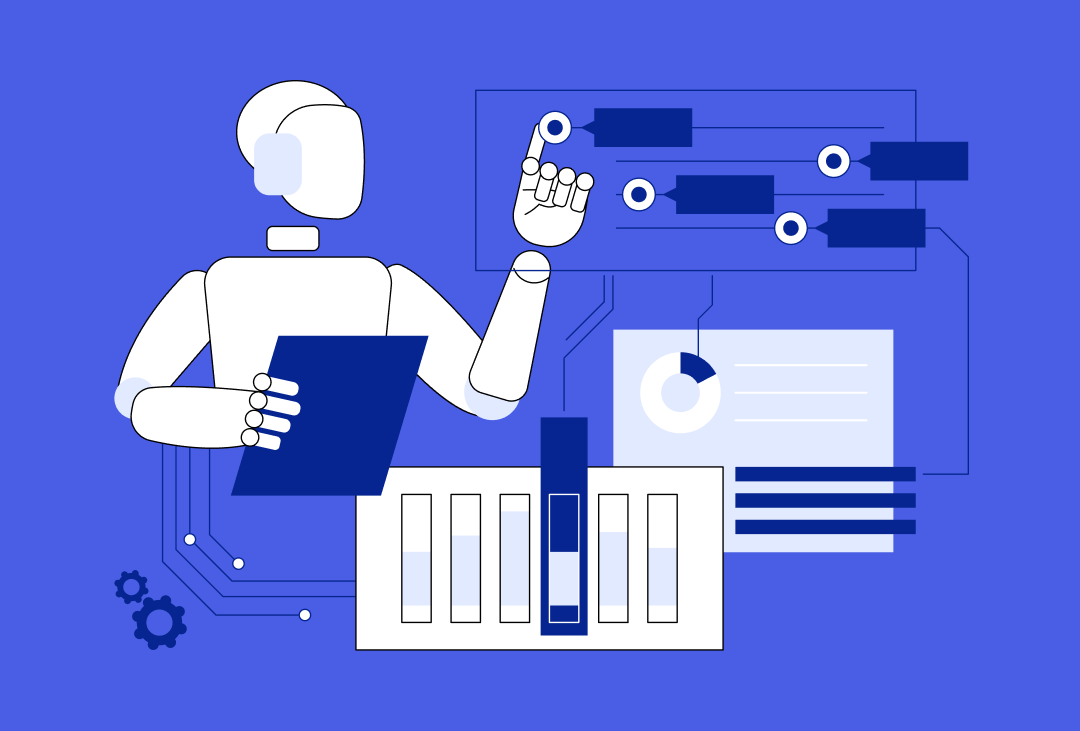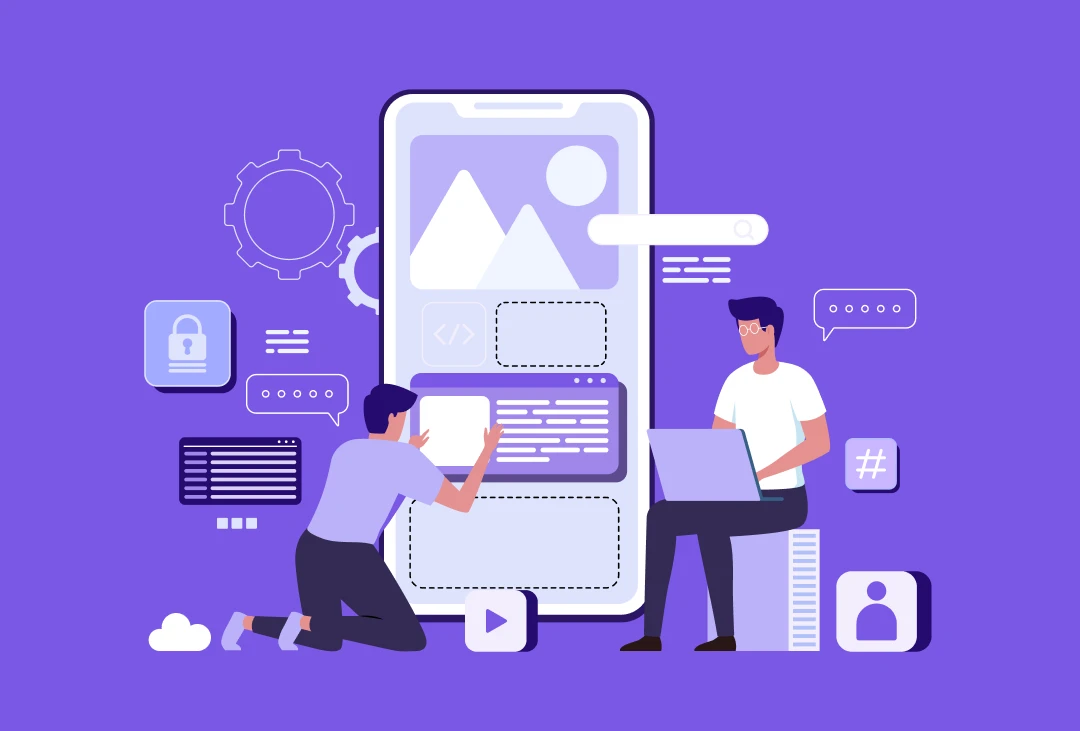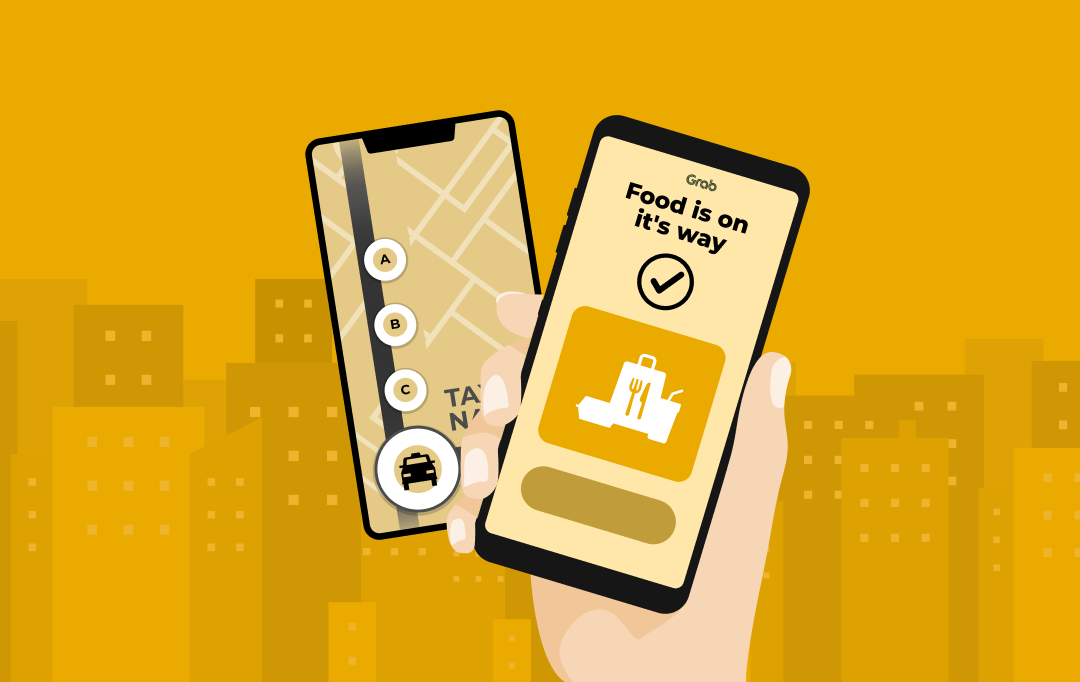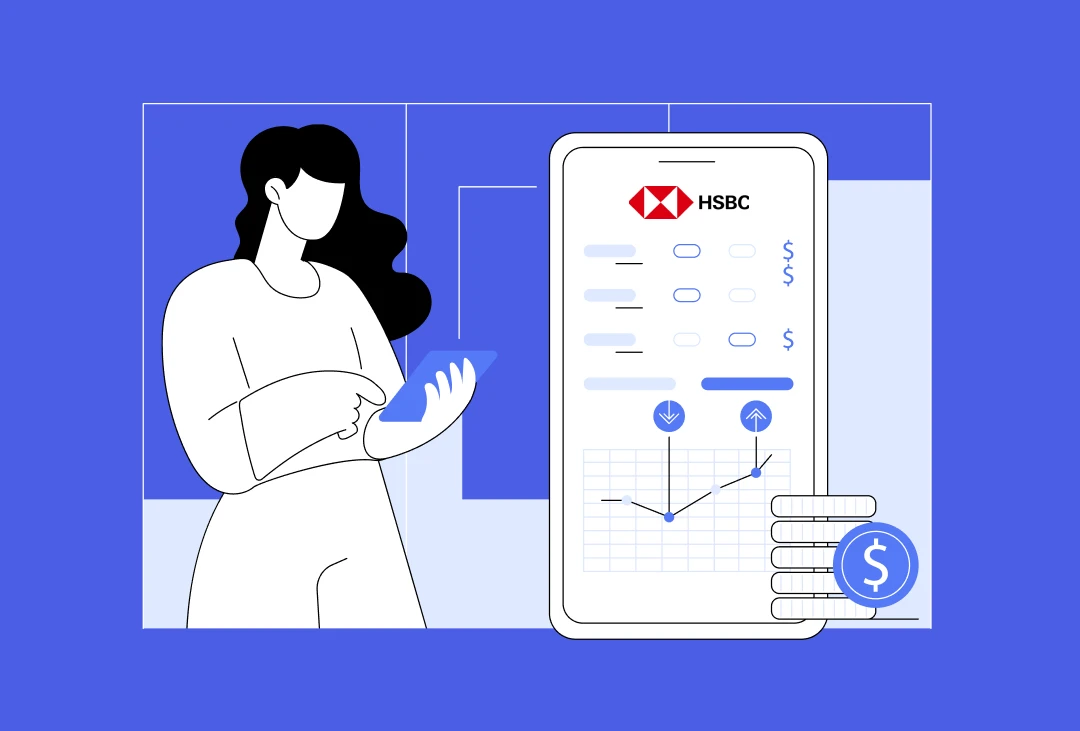Smartphone penetration has completely changed the conventional scenes of hospitals—long queues for payments, hassles accessing medical records, waiting lines in the visitors’ lounge, and manual appointment booking.
Now your healthcare assistant is in your pocket!
Thanks to tech innovations like healthcare mobile app development in Saudi Arabia, users can virtually do everything from booking appointments to accessing medical records and consulting with doctors. Thus, this ease in accessing healthcare services buoys healthcare businesses to create apps like Sehhaty.
As the Kingdom continues prioritizing digital health infrastructure, creating a healthcare app like Sehhaty will have a societal impact and business potential. For entrepreneurs and organizations alike, now is the time to join the shift and build smarter healthcare solutions for a smarter nation.
According to Fortune Business Insight, the Saudi Arabian healthcare services market size was valued at $241.13 billion in 2024. The market is projected to grow from $256.52 billion in 2025 to $412.25 billion by 2032, exhibiting a CAGR of 7.0% during the forecast period.

If you want to make an app like Sehhaty, you will be ahead in tapping the $412.25 billion opportunity in the coming years.
However, while considering developing a healthcare app similar to Sehhaty, you must have a question:
What would it cost to develop a healthcare app like Sehhaty in Saudi Arabia?
Depending on the app’s features, integrations, and scalability, the cost to build a healthcare app like Sehhaty typically ranges between $30,000 and $300,000 (SAR 100,000 to SAR 1,125,000).
In this blog, we’ll cover the Sehhaty app, how it works, and the complete cost breakdown to build a similar healthcare app. We’ll also explore the key cost factors, hidden expenses, and smart ways to optimize your budget. We’ll also share how to build and outperform an app like Sehhaty. Let’s dive in.
Sehhaty: Saudi Arabia’s Digital Gateway to Healthcare
Sehhaty is a digital healthcare platform launched by the Saudi Ministry of Health, designed to streamline access to medical services for citizens and residents across the Kingdom. As the national gateway to healthcare, the app consolidates various services, from appointment scheduling to health record management, into a single, user-centric interface.
According to Zawya, 94% of Saudi citizens reportedly using the Sehhaty app, it becomes the cornerstone of the Kingdom’s digital health transformation, offering more than 40 services ranging from telemedicine to prescription management.
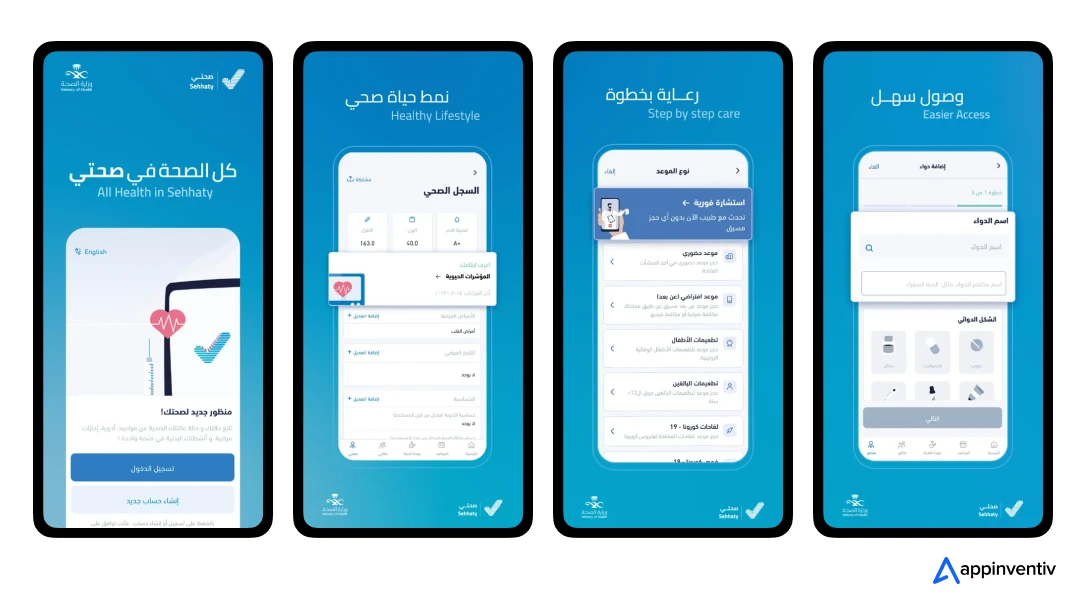
It served as a critical lifeline during the COVID-19 pandemic, enabling efficient coordination of testing and vaccination efforts, and has since evolved into a cornerstone of the country’s digital health transformation.
Sehhaty empowers users to manage their healthcare needs with greater autonomy and efficiency by seamlessly integrating with national health databases and facilities. It provides secure access to medical records, facilitates virtual and in-person consultations, and offers data-driven insights to promote preventive care.
Available on both iOS and Android platforms, Sehhaty exemplifies Saudi Arabia’s commitment to leveraging technology to improve public health outcomes and enhance patient experience.
According to a report by Sensor Tower, the Sehhaty app ranked among the top five Health & Fitness apps on Android in Saudi Arabia during Q3 2024, reflecting strong growth in downloads and user engagement. Sehhaty witnessed a steady rise in weekly downloads, growing from about 16.6K in early July to nearly 20.8K by late September 2024.
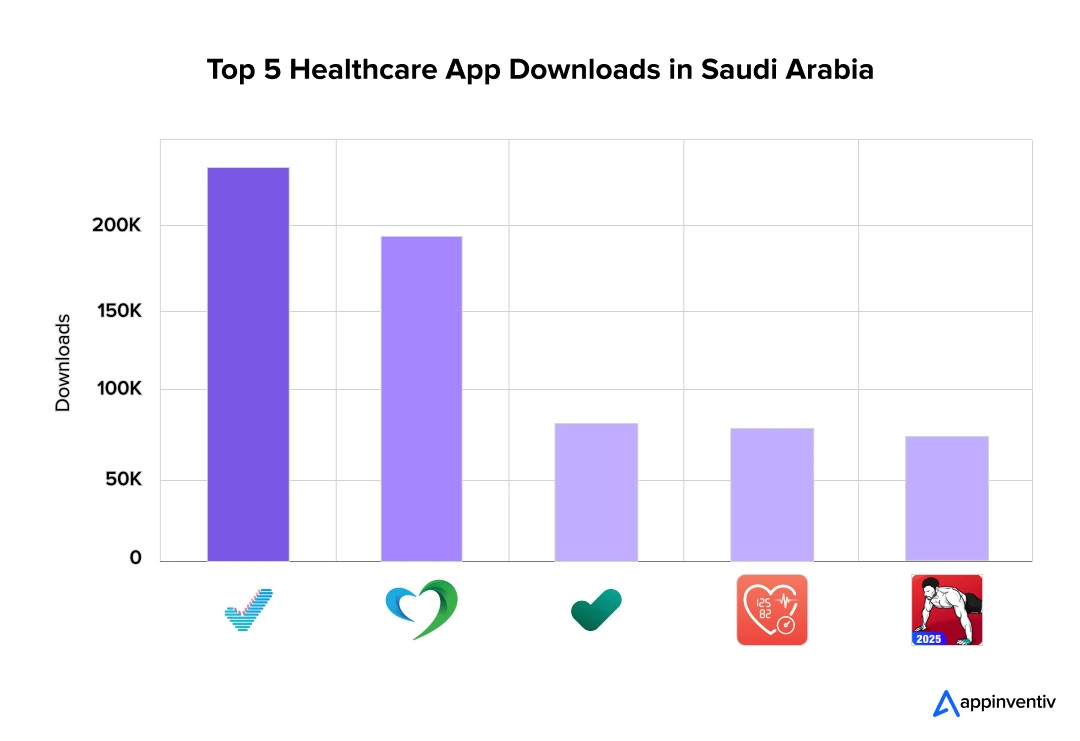
Increased digital adoption, government-backed healthcare initiatives, and the growing demand for accessible, tech-enabled medical services drive this rise. As public reliance on mobile health platforms deepens, Sehhaty continues solidifying its position as a cornerstone of Saudi Arabia’s digital health ecosystem.
Key Features of an App Like Sehhaty
A healthcare app like Sehhaty is designed to simplify and centralize medical services for users while ensuring a secure, connected, and personalized experience. Here’s a look at its essential features:

- Virtual Consultations: Connect with licensed doctors through real-time video or audio consultations.
- COVID-19 Test Results: Access PCR test results and vaccination status directly within the app.
- Medical Record Access: Securely view and manage personal health records, lab results, and medical history.
- Appointment Booking: Schedule doctor visits, virtual or in-person, at nearby healthcare centers with ease.
- E-Prescriptions: Receive and manage prescriptions digitally, with options for renewals or pharmacy pickup.
- Health Status Monitoring: Track daily health metrics and chronic conditions for ongoing care and insights.
- Vaccination Records: Store and display official immunization data for travel or healthcare needs.
- Government API Integration: Seamlessly sync with national health systems for accurate, real-time data access.
A Comprehensive View of the Sehhaty App Development Cost in Saudi Arabia
To create a healthcare app like Sehhaty, it is important to follow a multi-faceted process involving technical complexity, regulatory compliance, and user-centric design. The investment required can vary significantly based on the app’s scope, features, integration needs, and overall sophistication. Below is a detailed breakdown of costs and effort involved in such a project.
Cost Breakdown by App Complexity
The cost of building an advanced healthcare mobile app in Saudi Arabia depends heavily on its complexity. Basic versions with limited functionality are more cost-effective but offer fewer capabilities. In contrast, feature-rich, enterprise-level apps with AI, third-party integrations, and advanced data handling require a higher investment due to enhanced functionality and performance.
| Complexity Level |
Estimated Cost (USD) |
Estimated Cost (SAR) |
Features Included |
| Basic App |
$30,000 – $60,000 |
SAR 100,000 – 225,000 |
Appointment booking, basic user login, profiles |
| Moderate App |
$60,000 – $120,000 |
SAR 225,000 – 450,000 |
EHR access, video consultation, push notifications |
| Advanced App |
$120,000 – $300,000+ |
SAR 450,000 – 1,125,000+ |
AI diagnostics, wearable sync, government APIs |
Cost Breakdown by Development Stages
Every phase in the development lifecycle contributes to the overall cost to build a healthcare app like Sehhaty. Each stage requires careful planning and resource allocation, from research and design to launch and long-term maintenance.
| Stage |
Cost Allocation (% of Total) |
Key Activities |
| Planning & Research |
5% – 10% |
Market analysis, tech scope, compliance mapping. |
| UI/UX Design |
10% – 15% |
User flows, interface design, and prototypes. |
| Development |
50% – 60% |
Coding, API integrations, and security implementation. |
| Testing & QA |
10% – 15% |
Bug testing, performance, and security checks. |
| Launch & Deployment |
5% – 10% |
Infrastructure setup, publishing, and go-live checks |
| Maintenance & Updates |
15% – 25% annually |
Post-launch support, updates, and monitoring |
Formula to Estimate Sehhaty like App Development cost
A simple formula to estimate the cost to build a healthcare app like Sehhaty is:
Cost = Development Hours × Hourly Rate
Time and Effort Estimates
The time required depends on the project scope and team size. More advanced applications typically require longer development cycles, rigorous testing, and broader expertise.
| Complexity |
Timeline |
Team Composition |
| Basic |
3 – 5 months |
1 PM, 2 Developers, 1 Designer, 1 QA |
| Moderate |
6 – 9 months |
1 PM, 3–4 Developers, 1–2 Designers, 2 QA |
| Advanced |
9 – 14+ months |
Full team, including API, DevOps, Security, UX/UI experts |
These cost breakdown stages are crucial in determining the final cost of developing an advanced healthcare app like Sehhaty. Properly estimating costs, aligning with healthcare regulations, and selecting the right technologies are critical for successful development and deployment.
Key Factors Influencing the Cost of Developing an Advanced Healthcare App Like Sehhaty in Saudi Arabia
The cost of building an advanced healthcare mobile app in Saudi Arabia, such as Sehhaty, requires careful consideration of numerous technical, regulatory, and operational factors. Each of these elements contributes to the time and costs associated with development. Below are the primary factors critical in determining the total investment required for such a complex digital solution.
Complexity of Design
The design of a healthcare app must prioritize UX/UI to ensure it is intuitive and accessible for all users. In a healthcare context, the design must also accommodate accessibility standards and the secure handling of sensitive data.
Custom graphics, interactive components, and a seamless experience across various devices (e.g., smartphones and wearables) elevate the overall cost to build a healthcare app like Sehhaty. High-quality design is vital for user engagement and the app’s credibility in healthcare.
Complexity of Backend Development (APIs, Servers, Databases)
The backend of a healthcare app is the backbone of its functionality. A robust backend system is required to manage complex tasks such as patient data storage, appointment scheduling, integration of medical records, and secure communication with healthcare providers.
Developing custom APIs, ensuring secure server environments, and managing large-scale databases require specialized expertise and substantial resources. The greater the sophistication of the backend features, the higher the Sehhaty app development cost in Saudi Arabia.
Third-party Integrations (Payment Gateways, Social Media, GPS, etc.)
Integrating third-party services such as payment gateways, social media login systems, GPS for location-based services, or connecting with third-party APIs (like wearables) adds considerable value to the app. However, each integration introduces a new layer of complexity, requiring additional development time for coding and testing.
For example, integrating payment systems or health insurance modules requires compliance with local regulations and introduces further costs due to their security and validation requirements.
Security and Compliance Measures
Given the sensitive nature of health data, robust security protocols are essential in protecting users’ personal and medical information. This includes end-to-end encryption, secure login systems with multi-factor authentication, and adherence to data protection regulations such as Saudi Health Information Exchange (SHIE), National E-Health Strategy, Saudi Data & Artificial Intelligence Authority (SDAIA), Saudi Health Council, Ministry of Health (MOH) Regulations, and National Health Information Center (NHIC).
This may include regular audits, consultations with legal experts, and the development of secure workflows and data management systems. The cost of compliance is often significant and can affect both the development timeline and overall healthcare app development cost.
Platform Selection
The choice of app platform—iOS, Android, or cross-platform—directly impacts the time and cost of medical app development in Saudi Arabia. Developing separate native apps for iOS and Android increases the cost substantially, as each platform requires distinct coding, testing, and maintenance.
On the other hand, opting for cross-platform development with tools like React Native or Flutter may offer cost savings. Still, it could come with limitations in terms of performance, access to platform-specific features, and scalability.
Technologies Utilized
The prevalence of Artificial intelligence across the MENA region either in the form of machine learning or data analytics has flipped the script of healthcare operations. Thus, choosing the right technology can significantly enhance the functionality of a healthcare app. For instance, AI-powered health assessments, predictive models, and personalized health recommendations require specialized algorithms and access to large datasets, thus increasing both the technical complexity and the cost.
A Sehhaty like app development cost often rises due to the integration of advanced technologies in healthcare. These tools typically require the expertise of specialized developers and data scientists, making the development process more resource-intensive
Complexity of Features
Including complex features such as telemedicine, real-time health tracking, digital prescriptions, or AI-driven medical diagnosis can drive up the overall Sehhaty app development cost in Saudi Arabia. Each feature requires extensive coding, integration, and testing to ensure it functions seamlessly, securely, and complies with healthcare regulations.
The more advanced the features, the more time-consuming the development process becomes, requiring a dedicated team of developers, testers, and compliance specialists to bring them to fruition.
Hidden App Development Costs of a Sehhaty-Style Healthcare App
While building a Sehhaty-style healthcare app might seem straightforward, hidden costs can quickly add up. These elements significantly impact healthcare app development cost, from compliance with Saudi-specific health data regulations to robust security frameworks and continuous AI model training for features like Digital Twin.
The Price of Staying Current
App maintenance is one of the most critical components of the Sehhaty app development cost in Saudi Arabia. Post-launch support includes bug fixes, OS updates, performance enhancements, and the addition of new features. Ongoing updates are essential, especially in healthcare, where regulations and user expectations evolve rapidly. Maintenance typically accounts for over 25% of the original development cost annually.
Also Read: Understanding App Maintenance Costs in 2025
Hosting Infrastructure
A substantial part of Sehhaty like App Development cost comes from reliable and secure hosting infrastructure. Hosting a healthcare app requires scalable cloud solutions with high uptime and data protection, particularly for sensitive medical records. Costs can escalate based on traffic volume, storage needs, and regulatory requirements for local data residency, especially in Saudi Arabia.
Marketing & Promotion
An often overlooked element of the custom healthcare app development cost in Saudi Arabia is marketing. Even the most feature-rich app must be actively promoted to gain visibility and attract users. Expenses include digital ads, social media campaigns, partnerships with healthcare institutions, and content creation. Marketing budgets can scale quickly depending on the outreach strategy and competitiveness of the digital health space.
Legal and Licensing Fees
Legal and compliance costs are essential to meeting healthcare regulations in Saudi Arabia. This includes drafting legal documents, securing user data licenses, consulting with regulatory experts, and obtaining certifications. These legal obligations ensure compliance, build user trust, and support the app’s long-term sustainability, affecting the Sehhaty like App Development cost.
Smart Ways to Optimize Sehhaty Like App Development Cost
Building a healthcare app like Sehhaty can be a significant investment, but strategic planning can help manage expenses without compromising quality. Here are four proven ways to control and optimize the overall cost to build a healthcare app like Sehhaty:
Start with an MVP
Launching a Minimum Viable Product (MVP) helps validate your app idea with minimal features and cost. It allows you to test core functionalities with real users and gather actionable feedback. This phased approach reduces initial investment while setting a clear direction for future development.
Focus on Core Features First
Concentrating only on the most essential features in the early stages ensures that your resources are directed toward solving users’ immediate needs. This approach limits complexity and allows for a faster launch. Additionally, non-critical features can be introduced gradually in later updates.
Go Cross-Platform
Utilizing cross-platform frameworks like Flutter or React Native lets you build for iOS and Android from a single codebase. This significantly reduces both development time and cost. It also ensures consistency in the user experience across devices, making it a cost-efficient choice for scalable apps.
Outsource Smartly
Outsourcing to skilled development teams in cost-effective regions can help reduce labor costs without sacrificing quality. Outsourcing becomes a powerful strategy when combined with clear communication, project management, and vetting. It enables faster development and access to a wider pool of expertise.
How to Build a Healthcare App Like Sehhaty: Step-by-Step Overview
Creating a feature-rich healthcare app requires strategic planning, the right technology, and adherence to local health regulations. Below is a simplified roadmap to help you navigate the process efficiently and effectively.
- Research and Define Your Vision: Understand user needs, market trends, and the digital healthcare landscape. This will help clarify your product goals and outline what’s necessary to develop an app like Sehhaty that aligns with user demand and healthcare priorities.
- Outline Core Features First: Map out the essential features, such as e-prescriptions, health records access, and appointment booking, that your app should deliver. This approach ensures you create a healthcare app like Sehhaty that’s both functional and user-centric from the very beginning.
- Choose the Right Technologies & Platforms: Select a technology stack that supports scalability, security, and cross-platform development. This is also crucial when considering the cost to develop a healthcare app like Sehhaty in Saudi Arabia, as tech choices directly impact your timeline and budget.
- Develop a Scalable Backend: Build a strong infrastructure for APIs, data storage, and real-time functionality. At this stage, you’ll also need to integrate privacy and security measures that meet Saudi Arabia’s healthcare data regulations and global standards.
- Test, Launch, and Iterate: Run multiple testing cycles to ensure performance, reliability, and user satisfaction. Once validated, move forward with deployment across iOS and Android. A phased launch can be a smart way to make an app like Sehhaty scalable and adaptable to user feedback.
- Support & Scale Over Time: After launch, your focus should shift to maintenance, regular updates, and scaling based on user demand. Continuous improvement ensures long-term success and aligns your app with the evolving healthcare ecosystem.
Ways to Build a Healthcare App That Outperforms Sehhaty
Creating a standout app in digital healthcare requires going beyond existing solutions to deliver innovative, user-centric features that address unmet needs. If you want to build something better than an app like Sehhaty, focus on delivering more value through design, functionality, and innovation. Here’s how:
Turn Design into a Competitive Advantage
Exceptional UI/UX is more than aesthetics. It’s about creating a frictionless experience for every user type. Simplify navigation, personalize the interface, and ensure accessibility for all. Thoughtful micro-interactions, real-time feedback, and a modern, responsive design can turn casual users into loyal ones.
Add Features Users Didn’t Know They Needed
To outperform existing apps, offer features that go beyond the basics. Think AI-powered health insights, real-time vitals integration via wearables, multilingual support, and virtual health assistants. By anticipating user needs and delivering proactive value, your app becomes more than a service; it becomes a daily companion. However, adding more features can increase the cost of building a healthcare app like Sehhaty.
Power the Experience with Advanced Tech
Future-proof your app with technologies that go beyond the conventional stack. Use AI for diagnostics, blockchain for healthcare data security, and cloud-native infrastructure for real-time performance. This enhances reliability and scalability and positions your app as a leader in digital health innovation.
Launch Your Sehhaty-Like Healthcare App with Appinventiv
With Saudi Arabia at the forefront of digital healthcare transformation, developing an app like Sehhaty is both a timely and strategic investment. The surge in user adoption and strong alignment with Vision 2030 highlights how critical mobile health platforms have become in modern care delivery.
As leaders in mobile app development services in Saudi Arabia, we have been instrumental in turning bold healthcare ideas into powerful digital products. Our work on Health-e-People, an integrated health ecosystem, and Soniphi, a personalized wellness diagnostic app based on voice analysis, showcases our ability to blend innovation with compliance and usability. We also created DiabeticU, an advanced diabetes management app that syncs effortlessly with wearable devices to deliver a seamless health tracking experience. The app features personalized meal planning, exercise recommendations, medication reminders, and real-time blood sugar monitoring.
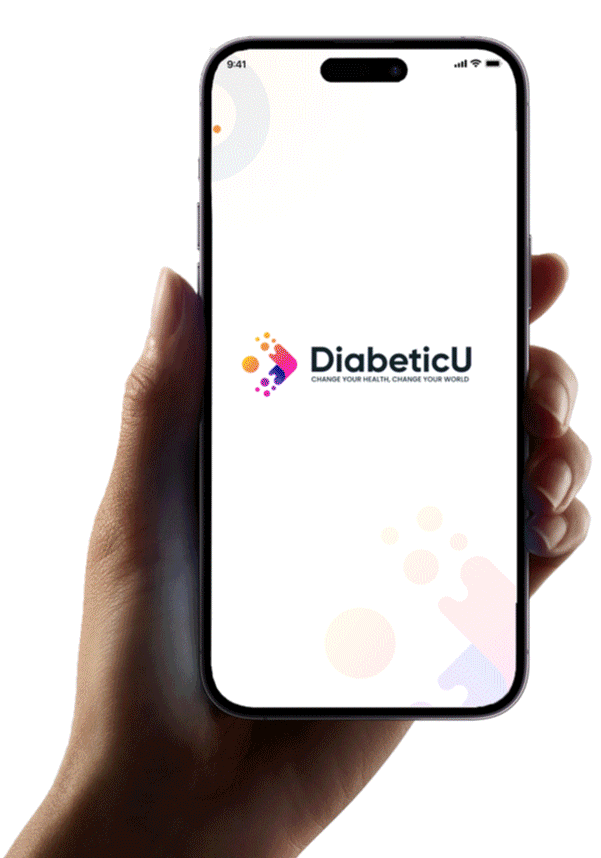
By leveraging smart data and user-specific insights, DiabeticU empowers individuals to better manage their condition and improve their overall well-being.
Whether your goal is to emulate Sehhaty’s model or build an even more advanced healthcare platform, our mobile app developers in Saudi Arabia have the expertise to bring your vision to life.
Let’s collaborate to create digital solutions that transform how healthcare is delivered today and into the future.
FAQs
Q. How to build a healthcare app like Sehhaty?
A. To develop an app like Sehhaty, it’s important to follow an agile roadmap that streamlines and quickens development. Here are the steps to develop one.
- Conduct market research
- Define core features
- Choose the right tech stack
- Design an intuitive UI/UX
- Develop an MVP first
- Ensure data privacy & compliance
- Test thoroughly
- Launch and monitor
- Plan ongoing maintenance
Q. How much does the Sehhaty app cost?
A. The cost to build a healthcare app like Sehhaty typically ranges from SAR 100,000 to SAR 1,125,000, depending on its overall complexity and feature set. Basic versions with limited functionality are more budget-friendly, while advanced solutions with AI, real-time integrations, and government API connectivity require a higher investment. Factors like platform selection, data security, and UI/UX design significantly impact the total development cost.
Q. How long does it take to develop an app like Sehhaty in Saudi Arabia?
A. The timeline for healthcare mobile app development in Saudi Arabia, especially for an advanced solution like Sehhaty, typically ranges from 4 to 9 months. This depends on several factors such as feature complexity, integration with national health systems, and regulatory compliance. While a basic MVP version may be completed in around 3–4 months, a robust, full-scale app with advanced features and security standards may take up to 9 months or more.
Q. What are the benefits of advanced healthcare app development in Saudi Arabia?
A. If you are making an app similar to Sehhaty, you can enjoy some noticeable benefits of advanced healthcare app development in Saudi Arabia
- High market demand of healthcare app development and user adoption
- Opportunity to align with Vision 2030 initiatives
- Competitive edge through digital innovation
- Streamlined operations and reduced overheads
- Access to government partnerships and funding opportunities
Product Development & Engineering
IT Managed & Outsourcing
Consulting Services
Data Services
Didn't find what you're looking for? Let us know your needs, and we'll tailor a solution just for you.
















